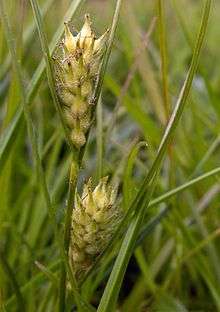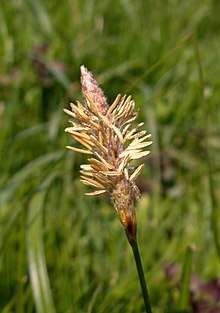Carex hirta
Carex hirta, the hairy sedge or hammer sedge,[1] is a species of sedge native across Europe. It has characteristic hairy leaves and inflorescences, and is the type species of the genus Carex.
| Carex hirta | |
|---|---|
 | |
| Female spikes | |
| Scientific classification | |
| Kingdom: | Plantae |
| Clade: | Tracheophytes |
| Clade: | Angiosperms |
| Clade: | Monocots |
| Clade: | Commelinids |
| Order: | Poales |
| Family: | Cyperaceae |
| Genus: | Carex |
| Subgenus: | Carex subg. Carex |
| Section: | Carex sect. Carex |
| Species: | C. hirta |
| Binomial name | |
| Carex hirta | |
Description

Carex hirta grows 15–70 centimetres (6–28 in) tall, with leaves 10–50 cm (4–20 in) long and 2–5 mm (0.08–0.20 in) (occasionally up to 8 mm or 0.3 in) wide.[2] The stems are trigonous (roughly triangular in cross-section), but with convex, rounded faces.[2] The leaves, leaf sheaths and ligules are all hairy, although plants growing in wetter positions may be less hairy; these have sometimes been separated as C. hirta var. sublaevis by Jens Wilken Hornemann, but this may not be a worthwhile taxon.[2] The culms bear 2–3 lateral female spikes, each 10–45 mm (0.4–1.8 in) long, and on half-ensheathed peduncles up to twice the length of the spike.[2] There are 2–3 male spikes at the end of the culm, each 10–30 mm (0.4–1.2 in) long.[2] The hairy utricles, male glumes and leaves make it hard to confuse Carex hirta with any other Carex species.[2]
Distribution
Carex hirta is native to Europe, and is found across the British Isles, albeit with records becoming very scarce in the far north.[3] It has been introduced to North America.[1] It was first recorded in Amherst, Massachusetts in 1877, and has since been found across much of the eastern United States and Canada.[4]
Nomenclature
Carex hirta is the type species of the genus Carex,[5] and therefore also of the subgenus Carex and the section Carex. It was described by Carl Linnaeus in his 1753 Species Plantarum, and the lectotype, from the herbarium of Adriaan van Royen, was designated by Ilkka Kukkonen in 1992.[6][7]
References
- "Carex hirta L." PLANTS Profile. United States Department of Agriculture. Retrieved June 1, 2011.
- A. C. Jermy; D. A. Simpson; M. J. Y. Foley; M. S. Porter (2007). "Carex hirta L.". Sedges of the British Isles. BSBI Handbook No. 1 (3rd ed.). Botanical Society of the British Isles. pp. 285–287. ISBN 978-0-901158-35-2.
- Peter Llewellyn (March 11, 2010). "Carex hirta hairy sedge". Wild Flowers of the British Isles. Retrieved June 1, 2011.
- "372. Carex hirta Linnaeus, Sp. Pl. 2: 975. 1753". Vol. 23. Cyperaceae. Flora of North America. eFloras.org. pp. 473, 498, 500, 501.
- Ilkka Kukkonen; Heikki Toivonen (1988). J. M. Bernard (ed.). "Taxonomy of wetland carices". Aquatic Botany. 30 (1–2): 5–22. doi:10.1016/0304-3770(88)90003-4.
- "Carex hirta Linnaeus". The Linnaean Plant Name Typification Project. Natural History Museum. October 9, 2006. Retrieved June 1, 2011.
- Subcommittee 3C (1992). "Seventy-two proposals for the conservation of types of selected Linnaean generic names, the report of Subcommittee 3C on the lectotypification of Linnaean generic names". Taxon. 41 (3): 552–583. JSTOR 1222833.